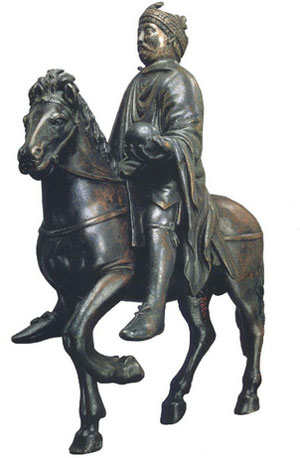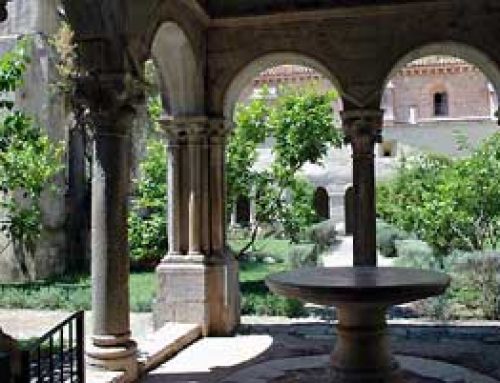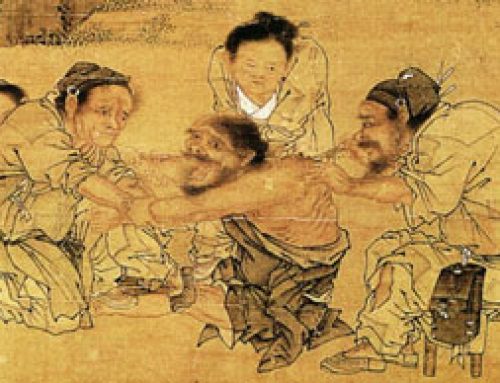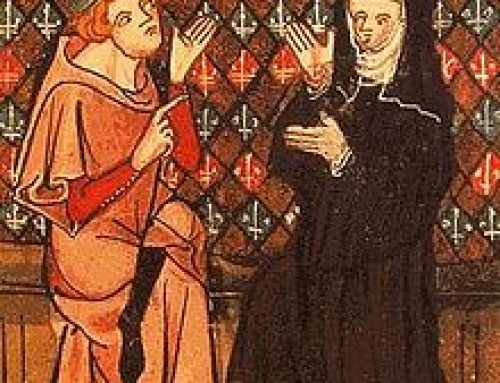
Who was Charlemagne? This is Charlemagne, or possibly his grandson (now in the Louvre Museum)
What’s Charlemagne’s real name?
Charlemagne’s name is really Charles le Magne, or Charles the Great. In German they call him Karl der Grosse, which also means Charles the Great.
Earlier Merovingians
All our medieval Europe articles
How did Charlemagne get into power?
Charlemagne’s father, Pippin, left Charlemagne his Frankish empire when he died in 768 AD. The Franks were already very powerful when Pippin died, but Charlemagne made them more powerful still.
More about Pippin
To begin with, Charlemagne organized a centralized system of governors (counts) throughout his kingdom, sending out men he knew to keep order all over his kingdom, and then sending out other men to check up on the counts.
More about feudalism
Who was Charlemagne?
Charlemagne also greatly expanded the size of his kingdom. He conquered France down to the Pyrenees mountains, and even into northern Spain. He crossed the Rhine river and conquered Germany, Switzerland and Austria, even into modern Hungary.
Islamic Spain
Early Medieval Hungary
Who were the Lombards?
To the north, he conquered Belgium. And in 774 AD Charlemagne also conquered the Lombards in northern Italy. In 778, Charlemagne led a successful raid into Islamic Spain to capture Indian steel swords.
Why did he want these Indian steel swords?
Then about 800 AD Charlemagne conquered the Avars. Charlemagne brought back thousands of Slavic prisoners from the Balkans to sell as slaves in France.
He brought back so many prisoners that people in his empire began to use the word “Slav” to mean slave, instead of the older Latin word “servus”, which started to mean “servant” as it does today.
Who were the Slavs? Where did they come from?
History of slavery
Charlemagne crowned Holy Roman Emperor

Who was Charlemagne? Charlemagne’s chapel at Aachen
From his position in northern Italy, Charlemagne was able to help out the Popes, who could no longer count on getting help from the Roman Empire. In exchange, Charlemagne got Pope Leo III in Rome to name him Holy Roman Emperor.
What is a Pope?
Irene and Charlemagne
Right at that moment (in 800 AD) the Roman Emperor in Constantinople was Irene, and the Franks refused to recognize Irene as Emperor because she was a woman.
Find out more about Irene
Irene and Charlemagne may have discussed getting married, to put a man back on the Roman throne and unite the old Roman Empire back into one Empire. They certainly considered having one of her sons marry one of his daughters, though in the end that didn’t happen.
But Irene’s advisers didn’t like this idea. They thought Charlemagne was just some barbarian nobody from northern Europe. Charlemagne didn’t care that much – he had plenty of power without Irene.

Who was Charlemagne? Charlemagne’s burial shroud, made of silk imported from Constantinople (814 AD)
Charlemagne’s palace at Aachen
Along with his new identity as Emperor, Charlemagne built up a real court at his palace in Aachen. Charlemagne had new buildings built there. There was a palace school. Charlemagne’s doctor, Farragut, was Jewish.
Charlemagne’s palace at Aachen
Many people wrote books at Charlemagne’s school in Aachen. One of these books was a biography of Charlemagne by Einhard which he modeled on the Roman biographer Suetonius.
Charlemagne and the Abbasid caliph
Charlemagne sent ambassadors back and forth to the Abbasid caliph, Harun al-Rashid, who sent him an Indian elephant as a present. Harun al-Rashid and Charlemagne discussed ways to
Abbasids in Iraq and Iran
Charlemagne lived to be an old man, though apparently he got a little tubby around the middle when he was middle-aged. He died when he was 72 years old, of pleurisy – an infection related to pneumonia. When Charlemagne died in 814 AD, his son Louis the Pious inherited his empire.
Charlemagne’s sons and grandsons
Learn by doing: make a clay statue of a person on a horse
More about the Carolingians
Bibliography and further reading about Charlemagne:





This information is priceless. How сan Ι fіnd ouut morе?
Thanks, Irene! You’ll find all our Middle Ages articles here: https://quatr.us/medieval-europe-articles-middle-ages
If you want more about Charlemagne, you could read the books in the bibliography at the end of the article. They’re very good!
If you want to put a price on the priceless, we’d love to have you as a Patron on our Patreon: https://www.patreon.com/quatr_us
Hey nice post. I hope it’s ok that I shared this on my Facebook,
if not, no problem just tell me and I’ll delete it.
Regardless keep up the good work.
I’m delighted that you shared it! Thanks!
I really like studying and I believe this website got some genuinely utilitarian stuff
on it!
Thanks! I’m glad we could help.